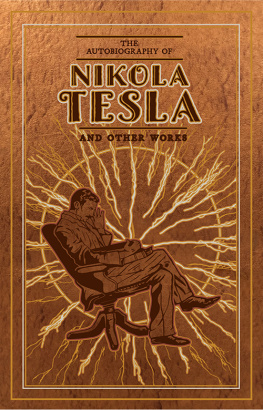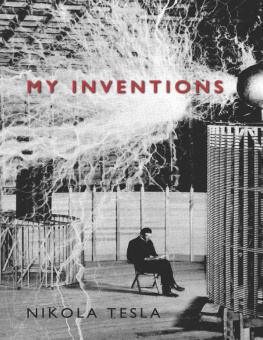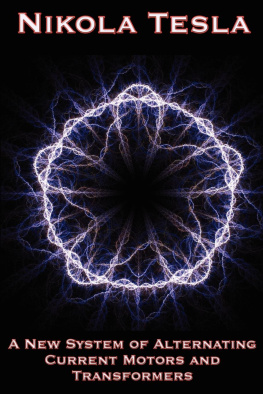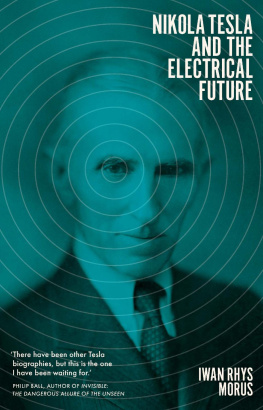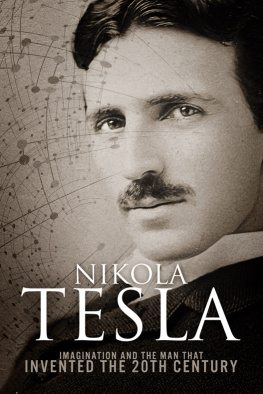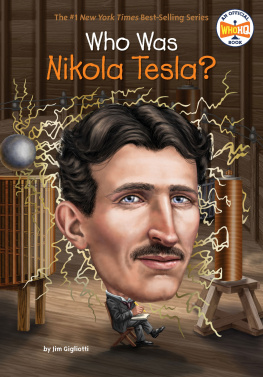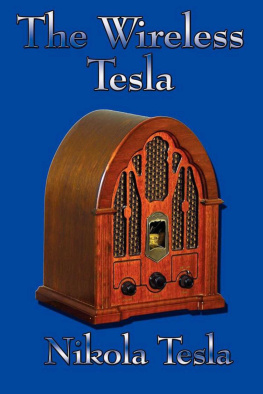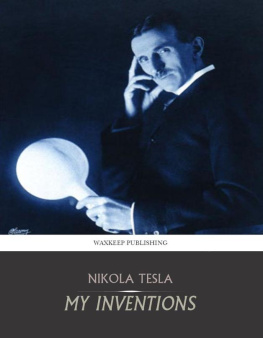Nikola Tesla - X-Ray Vision
Here you can read online Nikola Tesla - X-Ray Vision full text of the book (entire story) in english for free. Download pdf and epub, get meaning, cover and reviews about this ebook. year: 2013, publisher: Start Publishing LLC, genre: Romance novel. Description of the work, (preface) as well as reviews are available. Best literature library LitArk.com created for fans of good reading and offers a wide selection of genres:
Romance novel
Science fiction
Adventure
Detective
Science
History
Home and family
Prose
Art
Politics
Computer
Non-fiction
Religion
Business
Children
Humor
Choose a favorite category and find really read worthwhile books. Enjoy immersion in the world of imagination, feel the emotions of the characters or learn something new for yourself, make an fascinating discovery.
- Book:X-Ray Vision
- Author:
- Publisher:Start Publishing LLC
- Genre:
- Year:2013
- Rating:5 / 5
- Favourites:Add to favourites
- Your mark:
- 100
- 1
- 2
- 3
- 4
- 5
X-Ray Vision: summary, description and annotation
We offer to read an annotation, description, summary or preface (depends on what the author of the book "X-Ray Vision" wrote himself). If you haven't found the necessary information about the book — write in the comments, we will try to find it.
Nikola Tesla is best known for his work with electricity, but he was also interested in Roentgen rays, better known today as X-rays. Collected here are his eight essays on Roentgen rays. Fascinating stuff from one of historys sharpest minds. Nikola Tesla has been called the most important man of the 20th Century. Without Teslas ground-breaking work wed all be sitting in the dark without even a radio to listen to.
X-Ray Vision — read online for free the complete book (whole text) full work
Below is the text of the book, divided by pages. System saving the place of the last page read, allows you to conveniently read the book "X-Ray Vision" online for free, without having to search again every time where you left off. Put a bookmark, and you can go to the page where you finished reading at any time.
Font size:
Interval:
Bookmark:
Start Publishing LLC
Copyright 2012 by Start Publishing LLC
All rights reserved, including the right to reproduce this book or portions thereof in any form whatsoever.
First Start Publishing eBook edition October 2012
Start Publishing is a registered trademark of Start Publishing LLC
Manufactured in the United States of America
10 9 8 7 6 5 4 3 2 1
ISBN 978-1-62793-273-8
by Nikola Tesla
Electrical ReviewMarch 11, 1896
One can not help looking at that little bulb of Crookes with a feeling akin to awe, when he considers all that it has done for scientific progress first, the magnificent results obtained by its originator; next, the brilliant work of Lenard, and finally the wonderful achievements of Roentgen. Possibly it may still contain a grateful Asmodeus, who will be lot out of his narrow prison cell by a lucky student. At times it has seemed to me as though I myself heard a whispering voice, and I have searched eagerly among my dusty bulbs and bottles. I fear my imagination has deceived me, but there they are still, my dusty bulbs, and I am still listening hopefully.
After repeating Professor Roentgens beautiful experiments, I have devoted my energies to the investigation of the nature of the radiations and to the perfecting of the means for their production. The following is a brief statement which, I hope, will be useful, of the methods employed and of the most notable results arrived at in these two directions.
In order to produce the most intense effects we have first to consider that, whatever their nature, they depend necessarily on the intensity of the cathode streams. These again being dependent on the magnitude of the potential, it follows that the highest attainable electrical pressure is desirable.
To obtain high potentials we may avail ourselves of an ordinary induction coil, or of a static machine, or of a disruptive discharge coil. I have the impression that most of the results in Europe have been arrived at through the employment of a static machine or Ruhmkorff coil. But since these appliances can produce only a comparatively small potential, we are naturally thrown on the use of the disruptive discharge coil as the most effective apparatus. With this .there is practically no limit to the spark length, and the only requirement is that the experimenter should possess a certain knowledge and skill in the adjustments of the circuits, particularly as to resonance, as I have pointed out in my earlier writings on this subject.
After constructing a disruptive coil suitable for any kind of current supply, direct or alternating the experimenter comes to the consideration as to what kind of bulb to employ. Clearly, if we put two electrodes in a bulb, or use one inside and another outside electrode, we limit the potential, for the presence not only of the anode but of any conducting object has the effect of reducing the practicable potential on the cathode. Thus, to secure the result aimed at, one is driven to the acceptance of a single electrode bulb; the other terminal being as far remote as possible.
Obviously, an inside electrode should be employed to get the highest velocity of the cathode streams, for the bulbs without inside terminals are much less efficient for this special object in consequence of the loss through the glass. A popular error seems to exist in regard to the concentration of the rays by concave electrodes. This, if anything, is a disadvantage. There are certain specific arrangements of the disruptive coil and circuits, condensers and static screens for the bulb, on which I have given full particulars on previous occasions.
Having selected the induction apparatus and type of bulb, tie next important consideration is the vacuum. On this subject I am able to make known a fact with which I have long been acquainted, and of which I have taken advantage in the production of vacuum jackets and all sorts of incandescent bulbs, and which I subsequently found to be of the utmost importance,. not to say essential, for the production of intense Roentgen shadows. I refer to a method of rarefaction by electrical means to any degree desirable far beyond that obtainable by mechanical appliances.
Though this result can be reached by the use of a static machine as, well as of an ordinary induction coil giving a sufficiently high potential, I have found that by far the most suitable apparatus, and one which secures the quickest action, is a disruptive coil: It is best to proceed in this way: The bulb is first exhausted by means of an ordinary vacuum pump to a rather high degree, though my experiences have shown that this is not absolutely necessary, as I have also found it possible to rarefy, beginning from low pressure. After being taken down from the pump, the bulb is attached to the terminal of the disruptive coil, preferably of high frequency of vibration, and usually the following phenomena are noted. First, there is a milky light spreading through the bulb, or possibly for a moment the glass becomes phosphorescent, if the bulb has been exhausted to a high degree. At any rate, the phosphorescence generally subsides quickly and the white light settles around .the electrode, whereupon a dark space forms at some distance from the latter. Shortly afterward the light assumes a reddish. color and the terminal grows very hot. This heating, however, is observed only with powerful apparatus. It is well to watch the bulb carefully and regulate the potential at this stage, as the electrode might be quickly consumed.
After some time the reddish light subsides, the streams becoming again white, whereupon they get weaker and weaker, wavering around the electrode until they finally disappear: Meanwhile, the phosphorescence of the glass grows more and more intense, and the spot where the stream strikes the wall becomes very hot, while the phosphorescence around the electrode ceases and the latter cools down to such an extent that the glass near it may be actually ice-cold to the touch. The gas in the bulb has then reached the required degree of rarefaction. The process may be hastened by repeated heating arid cooling and by the employment of a small electrode. It should be added that bulbs with external electrodes may be treated in the same way. It may be also of interest to state that under certain conditions, which I am investigating more closely, the pressure of the gas ,in a vessel may be augmented by electrical means.
I believe that the disintegration of the electrode, which invariably takes. place, is connected with a notable diminution of the temperature. From the point on, when the electrode gets cool, the bulb is in a very good condition for producing the Roentgen shadows. Whenever the electrode is equally, if not hotter than the glass, it is a sure indication that the vacuum is not high enough, or else that the electrode is too small. For very effective working, the inside surface of the wall, where the cathode stream strikes, should appear as if the glass were in a fluid state.
As a cooling medium I have found best to employ jets of cold air. By this means it is possible to operate successfully a bulb with a very thin wall, while the passage of the rays is not materially impeded.
I may state here that the experimenter need not be deterred from using a glass bulb, as I believe the opacity of glass as well as the transparency of aluminum are somewhat exaggerated, inasmuch as I have found that a very thin aluminum sheet throws a marked shadow, while, on the other hand, I have obtained impressions through a thick glass plate.
The above method is valuable not only as a means of obtaining the high vacua desired, but it is still more important, because the phenomena observed throw a light on the results obtained by Lenard and Roentgen.
Font size:
Interval:
Bookmark:
Similar books «X-Ray Vision»
Look at similar books to X-Ray Vision. We have selected literature similar in name and meaning in the hope of providing readers with more options to find new, interesting, not yet read works.
Discussion, reviews of the book X-Ray Vision and just readers' own opinions. Leave your comments, write what you think about the work, its meaning or the main characters. Specify what exactly you liked and what you didn't like, and why you think so.


